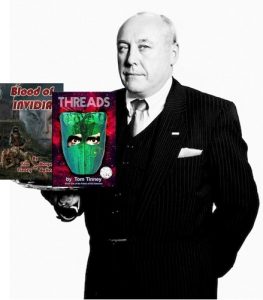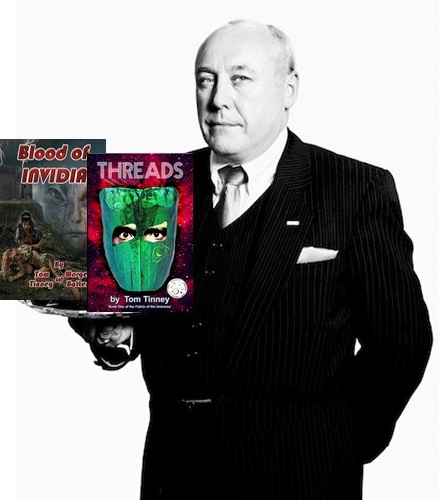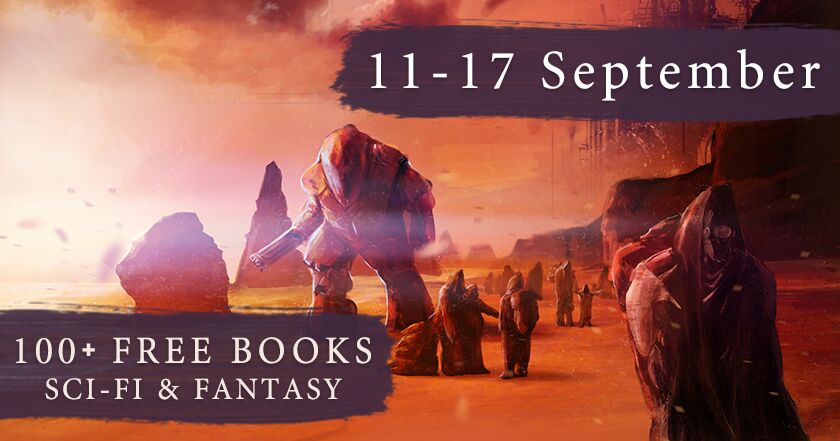 I was asked “How did you learn to write the entertaining and realistic dialogue in your novels?”.
I was asked “How did you learn to write the entertaining and realistic dialogue in your novels?”.
My first response was “How the hell would I know? It just comes out.”
I quickly realized that answer doesn’t help anyone and didn’t really answer the question. I had to think about it, for a bit, and might have flushed out some possibly helpful conclusions and observations.
Right off, I’m gonna be up front and say my first foray into fictional writing, and its accompanying dialogue, was very “Wooden” and unrealistic. Why? I think I was focused on what I thought it was supposed to sound like vs. what it would sound like if it occurred in the real world in real time. My initial diatribes were written so that every word had magnitude and relevance, as if spoken by a Shakespearean actor, imbuing intelligence, haughtiness, and sincerity in every turn of phrase. It was bad. Over-thought and contrived. Wooden.
Sounding familiar?
So how did I break that “mold”? The first thing that helped was having the work read back to me. Since I hadn’t started selling a lot of books at the time, I didn’t have a trusty British manservant at my disposal. It would’ve been handy to have “Alfred” bring me a whiskey as he read my words back to me while I hunted Gotham’s criminal element from my cavernous lair. Didn’t happen.
I explored other options. The spousal unit is NOT into SciFi, so she was out. If it doesn’t include grisly deaths by chainsaw, or some sort of thriller/romantic entanglement, she has zero interest. Luckily, I found an app on the Google Play Android store that helped. It’s called “FB READER”. It takes a couple of steps to load the ol’ “Work in Process” (WIP) into it, and fire it up, but it’s handy as hell. The steps were:
- Save Word Doc as HTML file on laptop
- Import HTML into “Calibre” program (Free online) as partial book
- Convert partial book HTML to Epub file format.
- Send Epub file to phone.
- Open the file in “FB Reader” app on phone
- Plug in headphones
- Tap “Speak+” option
At that point, a mechanical voice starts reading the text. I used the built-in settings to adjust the tone, speed and accents to a comfortable listening level and pace. BTW, I have done this with every book since and it has improved my all around writing and production speed.
For the first time I heard it, the narrator is narrating, the chapters start flying by, and THAT’S when it hit me. “Man, this doesn’t sound fluid or natural at all. I suck.”
How did I know it wasn’t the program? Well, I ran a copy of “Basilisk Station” through it, as well. David Weber’s dialogue sounded great. The cold hard truth was that my dialogue was seriously lacking. Please note that listening to the WIP also let me “hear” other issues, like double words, misspelled words, missing punctuation, or missing words mid-sentence that REALLY stick out when the app reads the work.
Great. Now we both know that the app told me I stunk up the book shelf when it came to dialogue. What you want to know is how I fixed it. It was easier than you might think. Experience. Not experience with writing dialogue, but in talking to a variety of people in various settings over my lifetime. We’ve all met (and will meet) various “personality types” in social, personal and business settings. I’m not talking about “portrayed” characters, with specific speaking traits needed for a movie or play (which I mimicked poorly in my “wooden” writing), but real people with distinct speech patterns, spewing their brand of word salads and with emotional context related to how they speak.
I went back to square one. I was writing my SciFi Space Opera novel “Threads”. I needed my character Matt to engage with a shipmate and say something relevant. Who was Matt most like? Was it someone that I had met? Probably not as a function of his job, a USS Marshall in the 26th century chasing a psychotic killer across the MetroStellar, but as a person. I knew this guy. If he and I were sitting across from each other, he’d sound like who? I picked someone I know. If Matt was that person, the next thing he would say would be “XXXX” and he’d say it like “XXXX”. I needed him to talk about an aspect of his job, so he would say it like “XXXX”. And there it was. The “real world” conversation that would be had by my fictional character is a mirror of that conversation with a person I have already met and know. It included markers, words and the personality of person “X”. It started to flow after that. By the time Morgen and I wrote “Blood of Invidia” a couple of years ( and a dozen short stories) later, the dialogue monster was long dead and the conversations flowed naturally.
In my life, I’ve met Charitable and Noble folks, Comedians, Business leaders, Engineer, Bikers, Servicemen, Snowflakes, Pompous jerks and some real assholes. Hard as nails to soft and squishy. Nervous to self-assured. Leaders and Followers. East coast, West coast. I’ve met people in different countries from a variety of social classes. They’ve given me the “dialogue ink well” in which to dip my figurative pen. I just picture a specific person (or maybe an amalgamation of a couple of people) and write what they would say, the way they would say it, in the situation at hand. No fluff. No puff. No “trying to make it sound cinematic”. No stereotypes (unless I have experience with one when dealing with that personality). Just very real. I let them speak to me within my framework.
With those words come the style, the pace, and the inflections. OMG…and the Contractions. Please use them in speech. Because real people use them. A lot. Also, feel free to “cheat” the spelling to elicit the pronunciation into a word between those quote marks. Some editors hate that. Oh, well, DO NOT CARE. It can make a statement “feel real” and is more immersive to the reader. Sometimes I type “Yeer” instead of “Your”. Why? You know why. You’ve stood next to the person that sounds that exact way. you hear “Year” but you know it’s “Your”. I’ll also use words shortened by an apostrophe (typically dropping the “g” from “ing”) if they fit the pattern.
If you read “Begging your pardon, Capt. Branson, sir, not exactly, sir. I have brought guests that wish to have a word with you, sir”, you picture a certain person and read it a particular way. Very proper. Stiff. I have handed my character over you to fill in the blanks.
BUT, if I write it like ““Beggin’ yeer pardon, Capt. Branson, sir, nay exactly, sir. I’ve brought guests that wish ta’ have a word with ye, sir.” It’s a different guy. You read it like he’s saying it. What conclusion do you reach? Well, the first may be that I spell like crap, but you read the accent, patter and speech pattern into it. Might he be Scottish? A wee bit o’ a smart ass? If I write him consistently throughout the work, the reader becomes very comfortable with the characters speech pattern (and odd spellings)…and so do I. Also, it’s friggin’ heeelarious when “FB Reader” stumbles its way through that sort of writing.
For the reader, chances are that they’ve met a similar person that acts a similar way. We get to tap into that when we let the reader ‘‘Listen in” to a realistic conversation with our dialogue’s “Mirror Man”. They’re living in our Universe at that point and more accepting of the plot arcs and journey we are taking them on. They relate to the characters and invest in them
There it is. My two-cents. in my writing today, my dialogue is vastly improved. When read, it doesn’t throw the readers out of the story and it stays true to the character. It’s repeatable through the book or across multiple stories. As I move into writing the next conversation the novel requires, I drop right into being “That Guy, Gal or third option Alien genre” and spew line after line in response to the plot arc, situation or other character.
Hope this helps stir your brain.
Nuff’ said.




